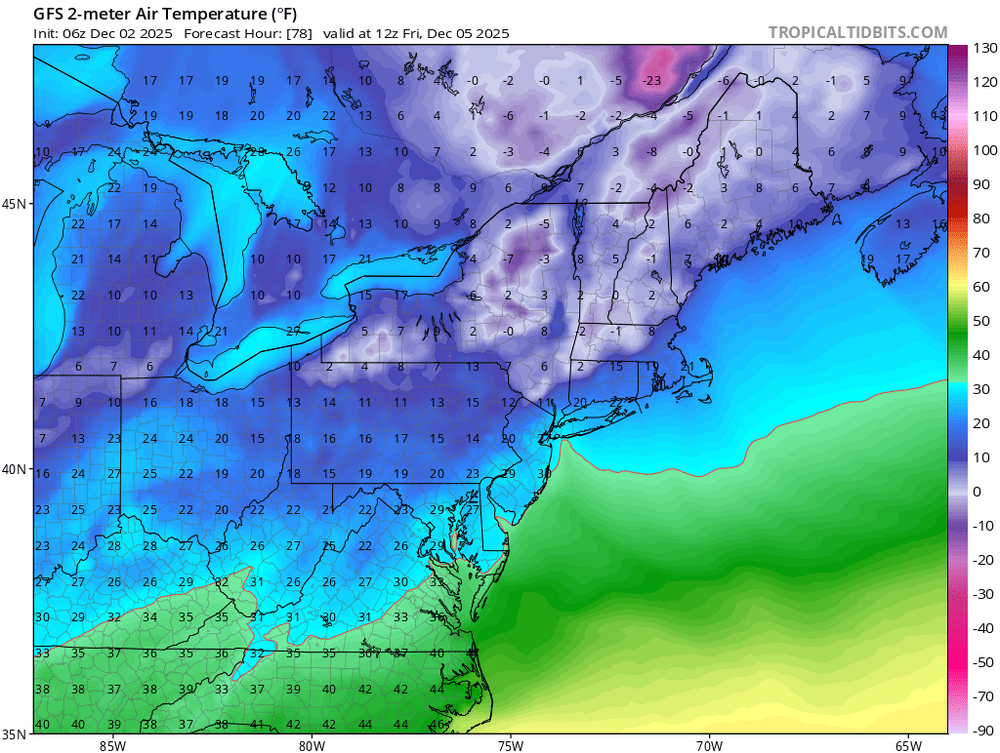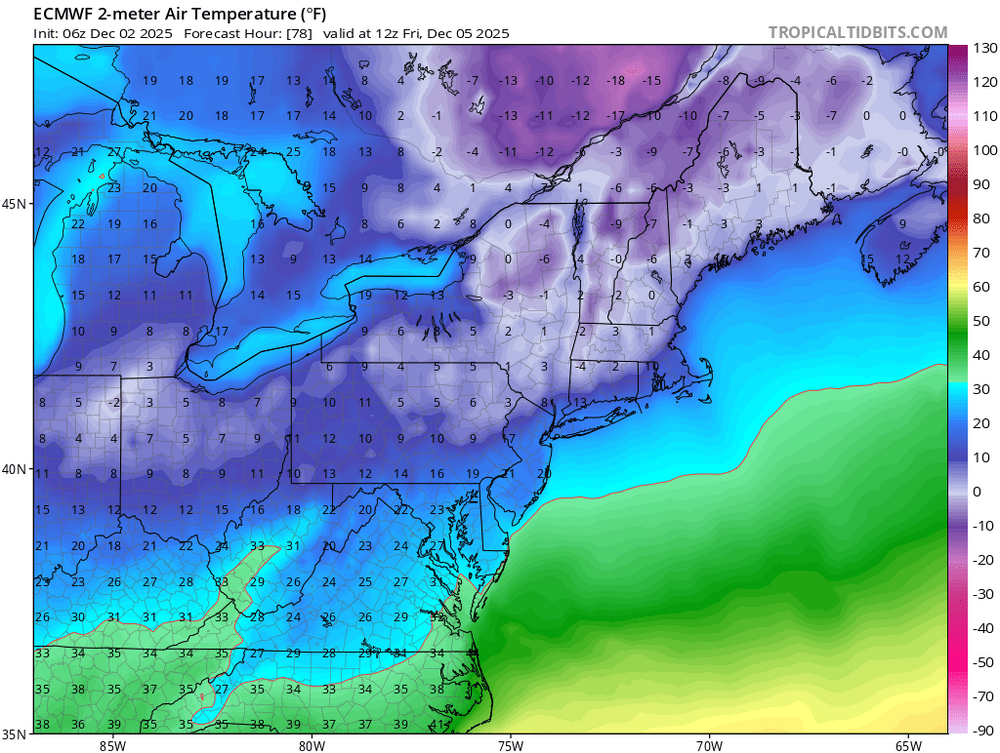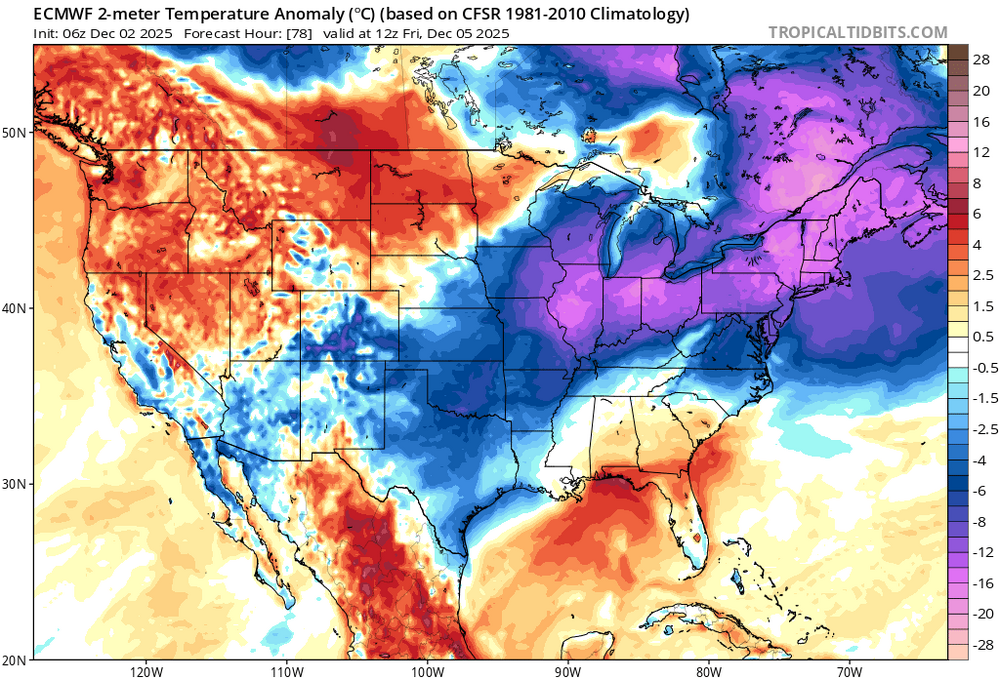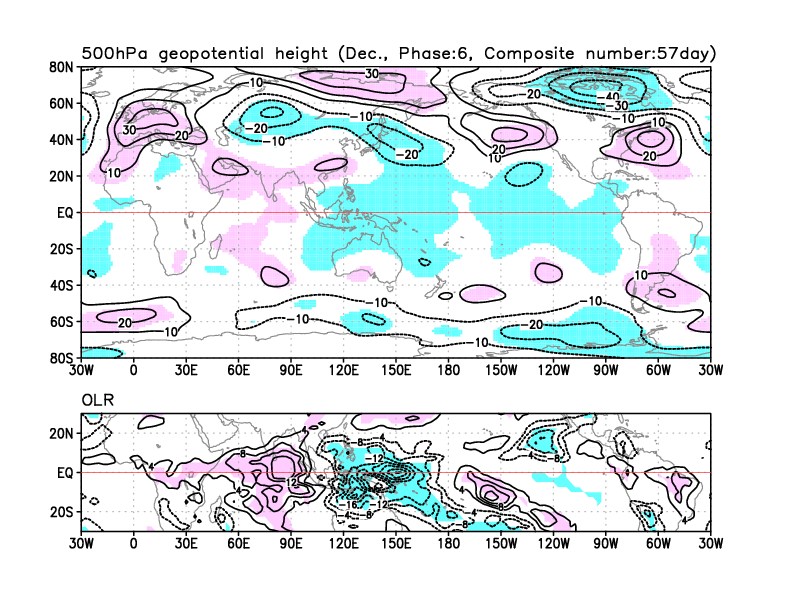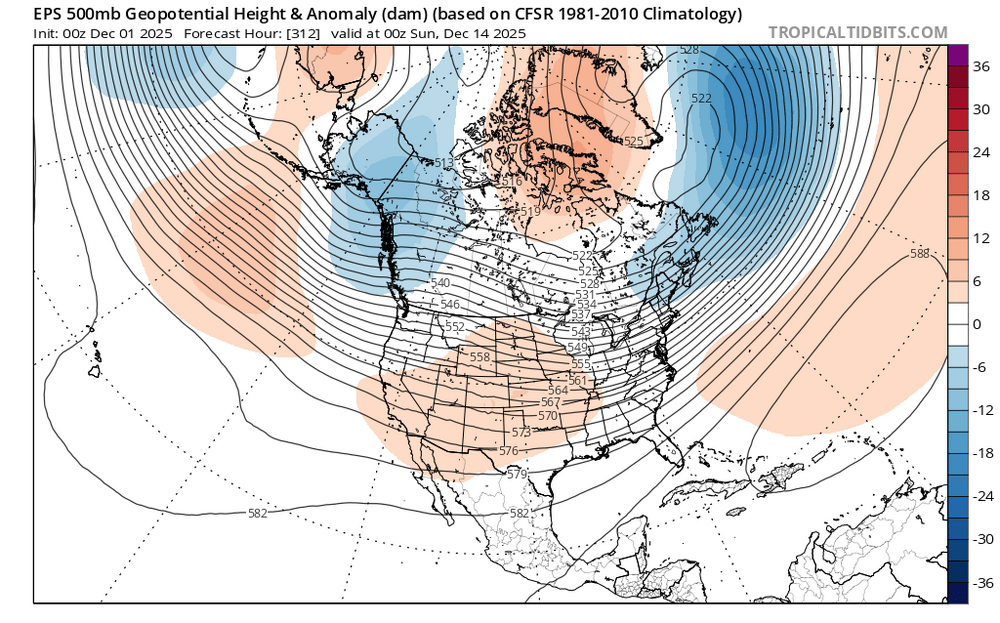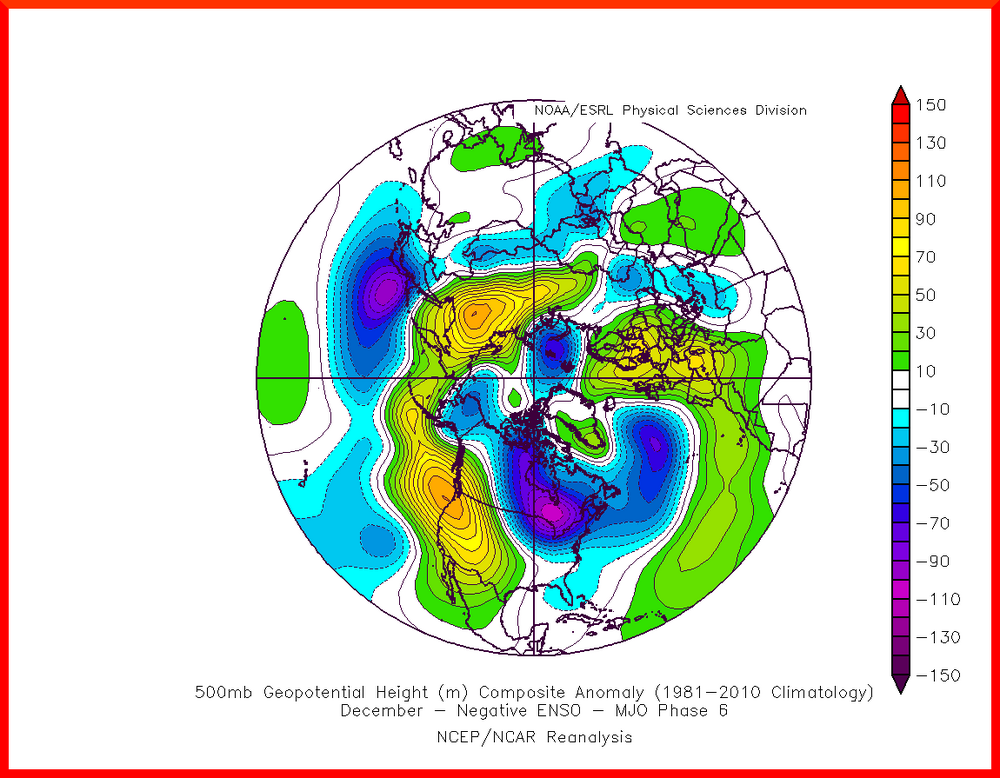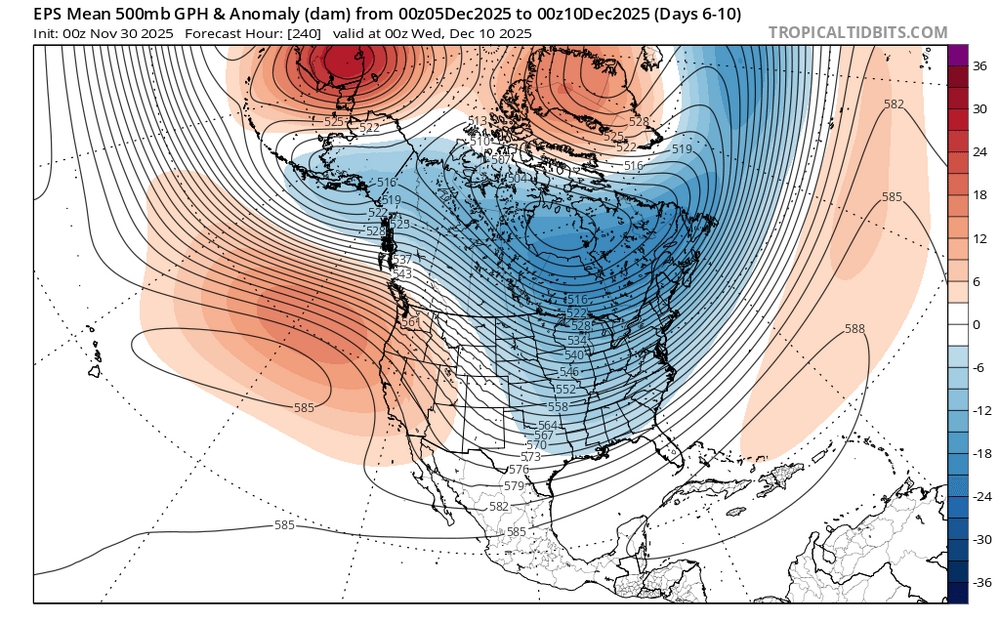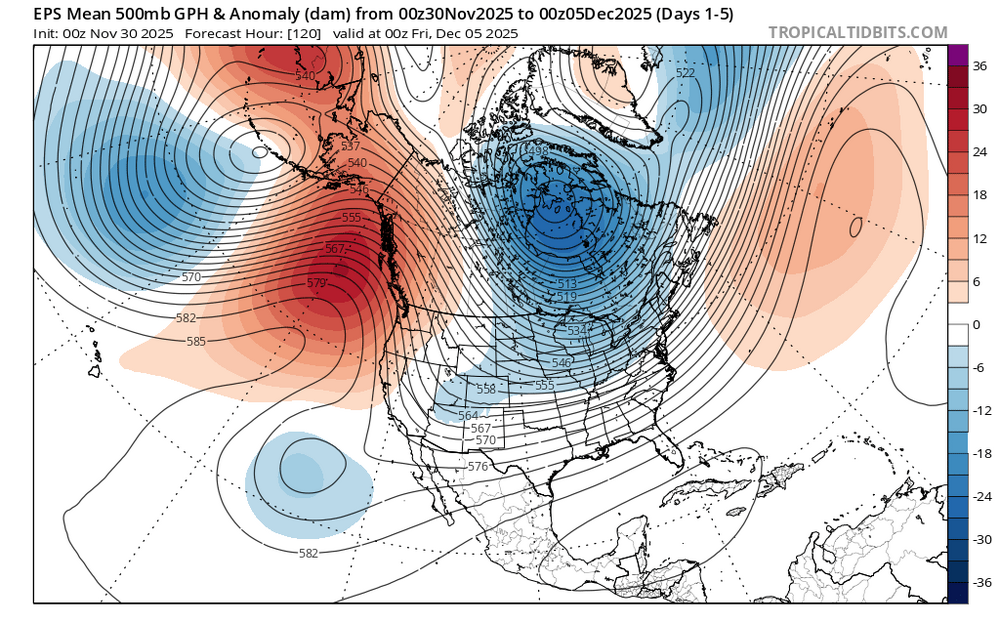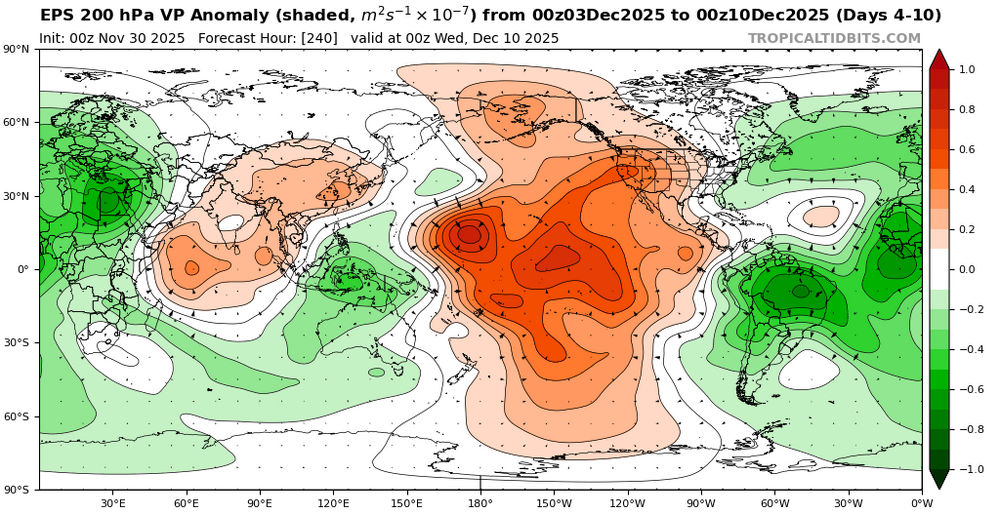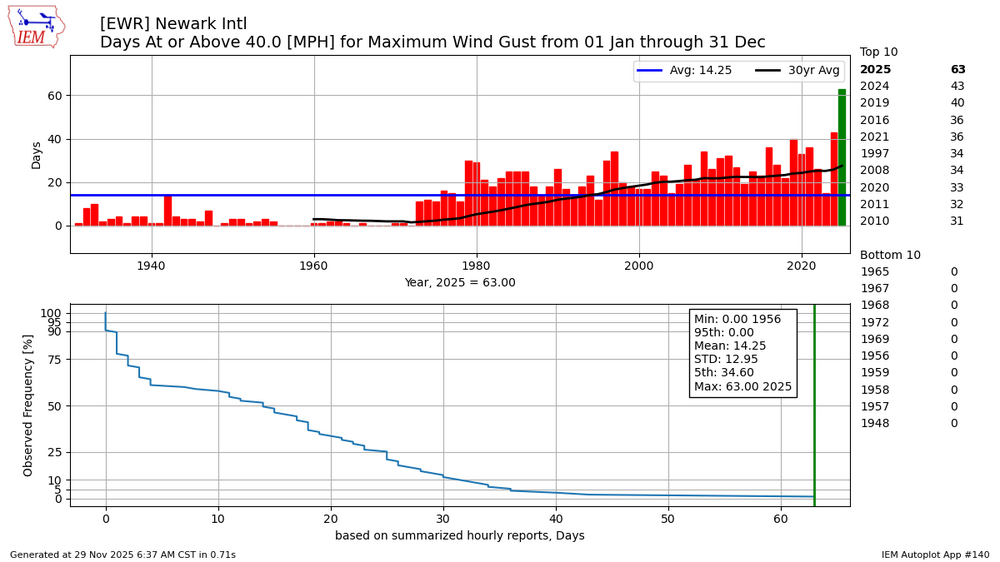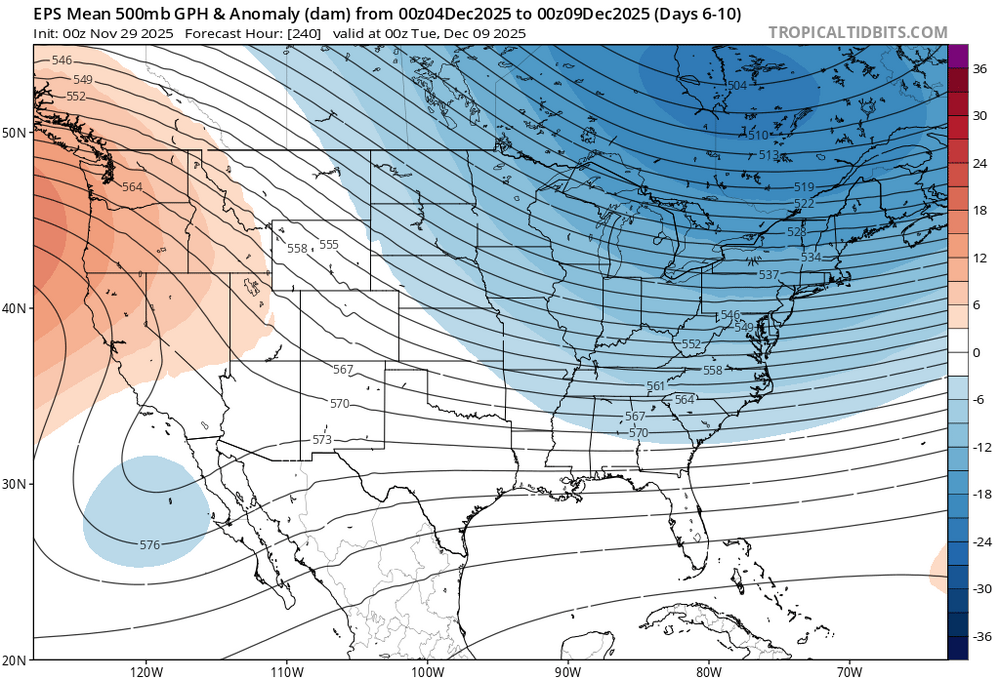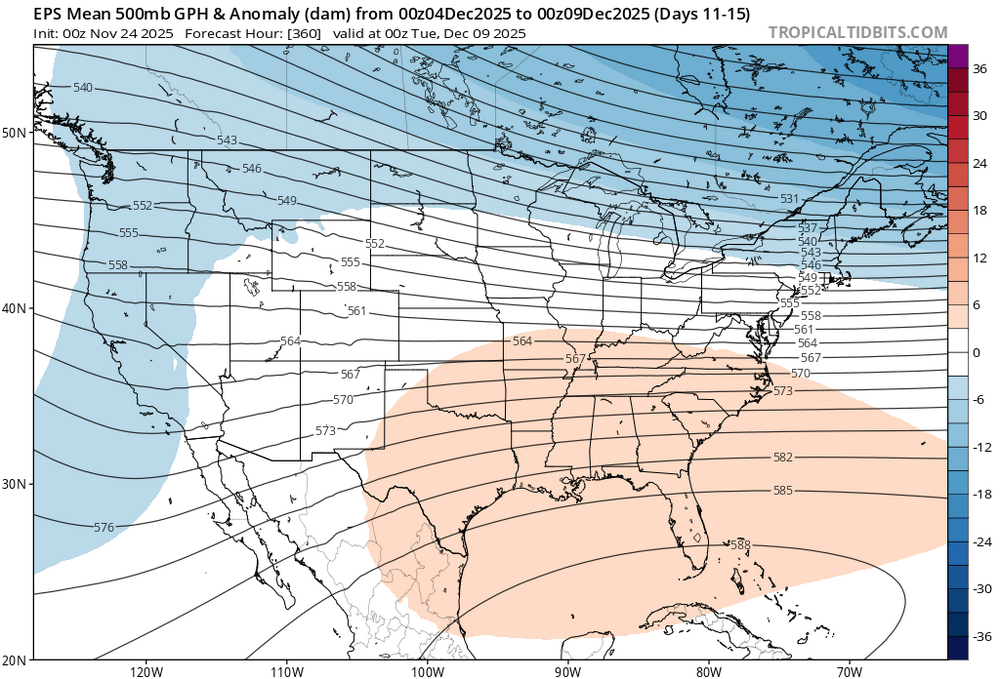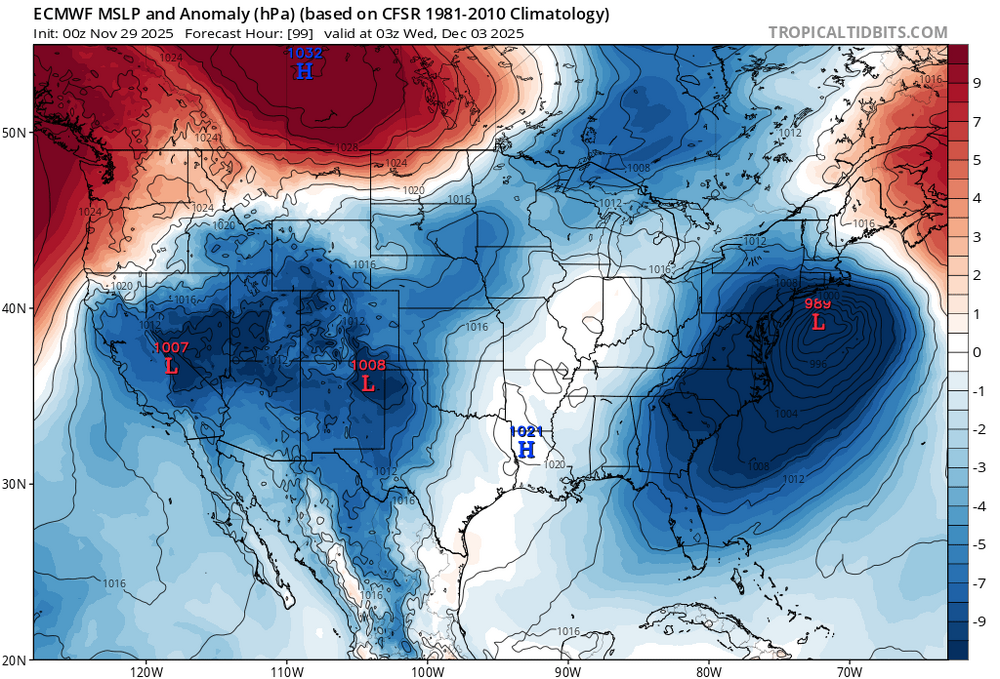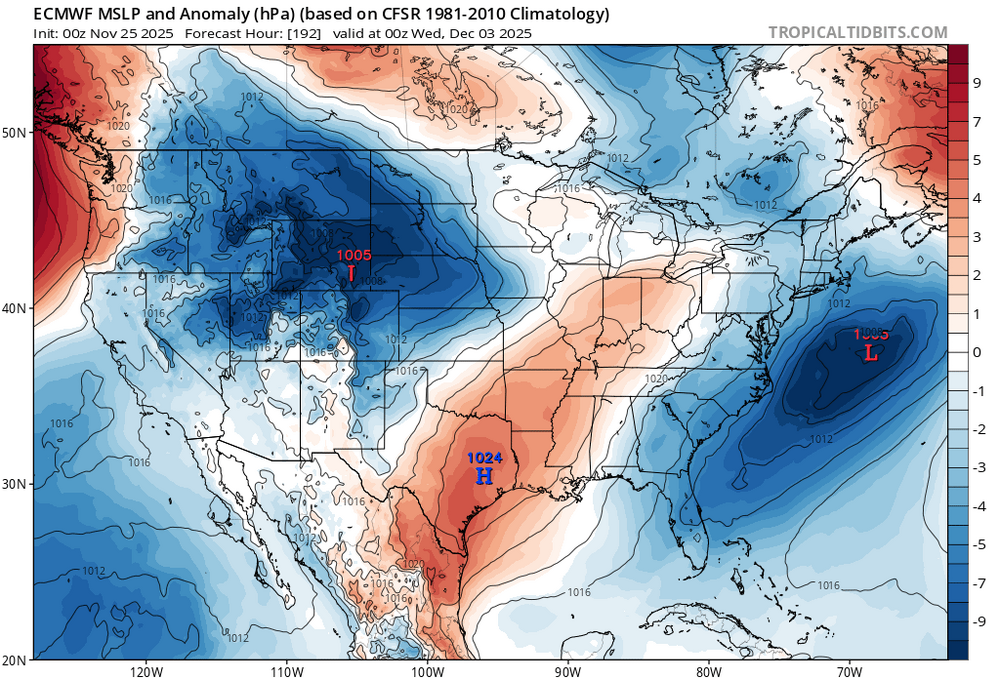-
Posts
35,884 -
Joined
-
Last visited
Content Type
Profiles
Blogs
Forums
American Weather
Media Demo
Store
Gallery
Everything posted by bluewave
-
-
While we couldn’t make any progress with the persistent warm storm track pattern next few days, at least we are finally getting an Arctic outbreak focused right over the Northeast Friday morning.
-
Another case of the Arctic sea ice record lows occurring outside of the annual minimum period in September since 2012.
-
The split forcing that I mentioned is preventing s clean MJO 8 response due to the interference leading to a moderation of the pattern mid month on the EPS. https://www.cpc.ncep.noaa.gov/products/precip/CWlink/MJO/mjoupdate.pdf The MJO resumed its eastward propagation while greatly strengthening in amplitude over the Western Pacific during the past week. • RMM observations currently show the signal at greater than 3 standard deviations in amplitude, the highest registered since March, 2024 • Based on objectively wave filtered upper-level velocity potential anomalies, the recent strengthening is likely tied to higher frequency wave modes constructively interfering with both the enhanced and suppressed MJO envelopes. • The strong Western Pacific MJO has led to a weakening of the La Nina background circulation over the equatorial Pacific, with convective anomalies developing off the equator. • As the faster propagating tropical variability moves away of the slower MJO envelopes, a transition towards more competing interference is favored, resulting in a substantially weakened MJO signal over the Western Hemisphere during the next two weeks. • Even with a weakened MJO, subseasonal forcing still favors the greatest chances for tropical cyclone development over the South Pacific, with lowered chances over the Indian Ocean. • The extratropical response associated with Western Hemisphere MJO events during December historically consists of development of high latitude blocking over/near Greenland, potentially allowing for Arctic air to be advected into portions of the central and eastern CONUS.
-
The EPS has been handling this pattern pretty well over the last week or so. It has been fairly steady with the MJO 6 500 mb pattern dominating. Longer duration MJO 6 patterns tend to show a poleward shift with more ridging returning to Plains and East after the first 10 days. This matches the moderation the EPS has been showing in the pattern for mid month. So the first 10 days or so will probably be the coldest part of December relative to the means.
-
It’s climo for recent gradient patterns no matter what winter month it is. We warm up enough for mostly rain near the coast with amped systems. This was the case last February. But since February is colder we were able to get a little more snow on the front end before the changeover.
-
A new tropical oscillation called the TWISO has been recently discovered. So maybe the reason we are getting a strong MJO 6 gradient pattern in early December is somehow related to it being out of phase with the MJO. Plus the split forcing between the Maritime Continent and the Western Hemisphere could also be creating an interference pattern. Models showing a MJO 6 interference gradient pattern in early December https://www.pnas.org/doi/10.1073/pnas.2511549122 The tropical climate variability is characterized by various oscillations across a range of timescales. Oscillations that imprint the tropical mean state are generally attributed to slow processes, such as the seasonal cycle or interannual variability. Here, we identify a pronounced tropics-wide intraseasonal oscillation (TWISO) in satellite observations and reanalyses. This oscillation, with a period of 30 to 60 d, is evident across multiple variables and involves interactions between convection, radiation, surface fluxes, and large-scale circulation. It is primarily manifested as convective perturbations in the tropical Indo-Pacific warm pool accompanied by oscillations in the large-scale tropical overturning circulation. Here, we examine the relationship between TWISO, the Madden–Julian Oscillation (MJO), and the instability of radiative-convective equilibrium. Certain phases of TWISO coincide with specific phases of the MJO, suggesting a potential connection between the two. However, although the MJO can amplify the oscillation amplitude of TWISO, it is not essential for TWISO to occur. Finally, due to its broad manifestation across the tropics, TWISO potentially exerts widespread influence on tropical weather and climate at regional scales.
-
That being said, gradient patterns in recent years have been setting up just north of NYC. We haven’t been near a gradient pattern jackpot zone since February 2014 and 1994. The WAR amps just enough on the storm days and the highs move east of New England. This is what the current models runs are showing for early December.
-
I am hoping we can get follow up storm systems tracking south of Long Island in the coming weeks and months when it’s colder. We saw a storm take a similar track on 12-5-20 to our south with mostly rain along the coast. With very amped systems early in the season we need strong Arctic high pressure over New England like we got back on 11-15-18.
-
Big story this year continues to be the strong W to NW flow behind the lows racing by to our north. So far this year has had 63 days at Newark with wind gusts reaching 40 mph or higher. This resulted in the impressive sieche on Lake Erie
-
Looks like a split decision showing up for the first week of December. Long range models shifted colder with the trough into the East instead of the ridge from previous runs. But the large storm on the 2nd and 3rd shifted warmer with a further north track and stronger WAR. Main issue with the storm is the very fast flow and lack of blocking allowed the high over New England to move off the coast. So the further north storm and slightly stronger WAR on the day of the storm pushed the rain to snow gradient just to the north and west of NYC. Since the colder start to December is a new pattern not showing up until day 6-10, it’s uncertain how the current day 11-15 and beyond will actually play out. If you look back on our recent Decembers, they have a tendency to start out cold from the 1st through 15th. Then we get the warm up every year since 2011 between the 17th and 25th. So it will be interesting to see how things actually play out vs what the models are currently showing. We would want to eventually see a colder storm for our area while we still have the cold. This is very important during La Nina’s since we need to get over 4” of snow in December to match the above vs below seasonal snowfall that I outlined a few days back in this thread. So hopefully we can connect with at least one storm next few weeks while the colder start is still nearby. New early December pattern colder than old runs Old run too warm for early December New run warmer storm further north on the 2nd and 3rd Old run storm track colder to the south and more suppressed
-
Split forcing between the Maritime Continent and the Western Hemisphere appears to be causing an interference pattern resembling a phase 6 in early December. It could also be why the models have been showing so much volatility between runs over the last week as we head into December. A Northeast Pacific +TNH with a a cold upper low centered near Hudson Bay more closely resembles a phase 6 composite. So trying to guess what composite or pattern we end up with in mid to late December is anyone’s guess at this point. We will just have to let things play out next few weeks to see which area of forcing eventually wins out.
-
When we subtract the recent strongest El Niños from the era before the warming of the WPAC warm pool, it shows what I have been talking about. The WPAC hasn’t been cooling down like it used to during strong El Niños. So this leads to the forcing shifting further west than it previously did during El Niños. This is why we had Niña-like elements combining with the 2015-2016 and 2023-2024 events. During the weaker 2018-2019 and 2019-2020 events they couldn’t even couple and the La Niña background more completely dominated.
-
The 20th heaviest snowfall total through 11-26 at Marquette is very respectable. Time Series Summary for Marquette County Area, MI (ThreadEx) Click column heading to sort ascending, click again to sort descending. 1 2014-11-26 55.0 0 2 1989-11-26 49.3 0 3 1991-11-26 46.9 0 4 2000-11-26 46.8 0 5 2002-11-26 46.6 0 6 1997-11-26 44.9 0 7 2008-11-26 43.7 0 8 1988-11-26 43.3 0 9 1992-11-26 41.4 0 10 2018-11-26 40.8 0 11 2022-11-26 40.7 0 12 2005-11-26 39.8 0 13 1979-11-26 39.0 0 14 1993-11-26 38.7 0 15 1975-11-26 36.3 0 16 1976-11-26 31.1 0 17 2020-11-26 31.0 0 18 1995-11-26 29.8 0 19 1981-11-26 29.2 0 20 2025-11-26 28.9 0
-
Very unusual to have the warmest Thanksgiving during the 12th coldest November. Climatological Data for NY CITY CENTRAL PARK, NY - November 1933 Click column heading to sort ascending, click again to sort descending. Sum 1450 1059 - - 687 0 0.90 0.5 - Average 48.3 35.3 41.8 -6.2 - - - - 0.0 Normal 54.0 42.0 48.0 - 511 1 3.58 0.5 1933-11-01 64 49 56.5 4.0 8 0 0.00 0.0 0 1933-11-02 65 50 57.5 5.3 7 0 0.00 0.0 0 1933-11-03 63 51 57.0 5.1 8 0 0.00 0.0 0 1933-11-04 54 38 46.0 -5.6 19 0 0.00 0.0 0 1933-11-05 41 29 35.0 -16.3 30 0 0.10 0.1 0 1933-11-06 39 33 36.0 -15.0 29 0 0.33 0.1 0 1933-11-07 46 37 41.5 -9.1 23 0 T 0.0 0 1933-11-08 44 34 39.0 -11.3 26 0 T T 0 1933-11-09 44 32 38.0 -12.0 27 0 T T 0 1933-11-10 40 32 36.0 -13.7 29 0 0.00 0.0 0 1933-11-11 45 28 36.5 -12.9 28 0 0.04 0.0 0 1933-11-12 45 35 40.0 -9.1 25 0 0.00 0.0 0 1933-11-13 59 38 48.5 -0.3 16 0 0.08 0.0 0 1933-11-14 43 32 37.5 -11.0 27 0 T T 0 1933-11-15 32 21 26.5 -21.6 38 0 0.00 0.0 0 1933-11-16 30 17 23.5 -24.3 41 0 0.00 0.0 0 1933-11-17 36 19 27.5 -20.0 37 0 0.00 0.0 0 1933-11-18 41 36 38.5 -8.7 26 0 0.14 0.3 0 1933-11-19 39 34 36.5 -10.4 28 0 T T 0 1933-11-20 49 35 42.0 -4.6 23 0 0.00 0.0 0 1933-11-21 58 32 45.0 -1.3 20 0 T 0.0 0 1933-11-22 60 47 53.5 7.5 11 0 0.04 0.0 0 1933-11-23 48 37 42.5 -3.2 22 0 0.00 0.0 0 1933-11-24 43 32 37.5 -7.9 27 0 0.00 0.0 0 1933-11-25 50 36 43.0 -2.0 22 0 0.00 0.0 0 1933-11-26 55 43 49.0 4.3 16 0 0.17 0.0 0 1933-11-27 43 28 35.5 -8.9 29 0 0.00 0.0 0 1933-11-28 54 32 43.0 -1.1 22 0 0.00 0.0 0 1933-11-29 51 42 46.5 2.7 18 0 0.00 0.0 0 1933-11-30 69 50 59.5 16.0 5 0 0.00 0.0 0 Coldest November Time Series Summary for NY CITY CENTRAL PARK, NY - Month of Nov Click column heading to sort ascending, click again to sort descending. 1 1873 37.2 2 2 1871 38.8 0 3 1880 38.9 0 - 1875 38.9 0 4 1882 39.0 0 5 1901 39.7 0 6 1869 40.6 0 7 1887 41.2 0 8 1894 41.3 0 9 1872 41.4 0 10 1917 41.6 0 11 1976 41.7 0 12 1933 41.8 0
-
I wonder how strong of an El Nino would be necessary to completely take the record WPAC warm pool out of the equation? Even during the 2015-2016 record super event, we still got the record MJO 5 for such a strong El Nino in December 2015 leading to the +13 that month around NYC. Thankfully, there was a major improvement during January and February 2016. But our next El Nino attempts in 2018-2019 and 2019-2020 were too weak to fully couple due to that record WPAC warm pool leading to the strong La Nina background patterns. Then the borderline super event in 2023-2024 had the record forcing and SST warmth from the IO into the WPAC for such a strong El Nino. This lead to the record warmth and 500mb ridging in Canada extending down into the US with no Nino trough development in the East.
-
Yeah, short term is the key phrase as those near to record SSTs extend down well below the surface which were recently enhanced by the record IOD.
-
You can see how the long range models continue to underestimate the forcing near the Maritime Continent with the record warm pool there leading to the stronger Northern Stream of the Pacific Jet. So it interferes with the progression to a true MJO 8 500 mb and storm track pattern with the weaker Pacific Jet. This is why the RMM charts appear to show a slowdown or loop near the 7-8 border and lowering amplitude toward the circle following the higher amplitude 7. New run Old run WPAC warm pool with expansive area of +28C to +30C SSTs
-
Early first snow for Paris also.
-
A record number of days this year for gusts over 40mph with so many lows racing through the Great Lakes.
-
NYC still waiting for their first 32° freeze and ISP their first 28° hard freeze. These minimums for the fall are near the warmest for the season. Same for FWN in NW NJ which still hasn’t dropped below 20° yet. Time Series Summary for NY CITY CENTRAL PARK, NY - Sep through Nov Warmest fall min temps Click column heading to sort ascending, click again to sort descending. 1 1998 36 0 2 2009 35 0 - 2006 35 0 3 2016 34 0 - 2010 34 0 - 2001 34 0 - 1963 34 0 - 1902 34 0 4 2025 33 4 - 2011 33 0 - 1985 33 0 - 1948 33 0 - 1907 33 0 5 2015 32 0 - 1983 32 0 - 1968 32 0 - 1954 32 0 Time Series Summary for ISLIP-LI MACARTHUR AP, NY - Sep through Nov warmest fall min temps Click column heading to sort ascending, click again to sort descending. 1 1983 30 0 2 2025 29 4 - 2011 29 0 - 2006 29 0 3 2009 28 0 - 1985 28 0 4 2024 27 0 - 2016 27 0 - 1998 27 0 - 1980 27 0 - 1979 27 0 - 1977 27 0 - 1971 27 0 5 2012 26 0 - 2010 26 0 - 1988 26 0 - 1984 26 0 Time Series Summary for SUSSEX AIRPORT, NJ - Sep through Nov Warmest fall min temps Click column heading to sort ascending, click again to sort descending. 1 2025 22 4 - 2011 22 6 - 2009 22 0 - 2006 22 0 2 2024 21 0 3 2023 20 5 - 2017 20 0 - 2016 20 8 4 2021 19 0 - 2020 19 0 - 2012 19 5 - 2004 19 0 - 2001 19 1 5 2015 18 0 - 2010 18 0 - 2003 18 0 - 2002 18 0
-
December 3rd will probably be a good sample of what the storm tracks will do this winter. The last 7 winters we have seen a very dominant and fast Northern Steam of the Pacific Jet lead to three dominant storm tracks. Track #1 has been a Great Lakes cutter leading an amplified Southeast ridge and mostly rain near the coast. In this case there is enough separation in the fast Pacific flow for one system to really amplify pumping the Southeast ridge on the day of the storm. Track #2 featured just enough wave separation for an I-78 to I-84 hugger storm track. This has been a snow to sleet and rain scenario along the coast. A bit of a WAR or Western Atlantic ridge on storm day. Sometimes the low slips south and the rain to snow line shifts north of NYC and coast due to the stronger WAR or Southeast ridge on storm day. Track #3 has seen kicker troughs coming into Western North America suppressing the Southern Stream storm tracks. The Benchmark track with a record number of KU snowstorms which has dominated from 2010 to 2018 has been largely absent leading to the record low snowfall last 7 seasons. This has been a result of the much stronger Northern Stream of the Pacific Jet since 2018-2019. If we can get the storm track on December 3rd to show some small deviation, then maybe we can see at least some small improvement this winter. We would want to see a deep enough coastal development near the Benchmark to have some hope in snowfall improvement this winter. Since 1995-1996 we have had 15 La Niña winters as defined by the RONI index. 14 out of 15 of those winters followed a repeating pattern which has been common the last 30 years. EWR, NYC, and LGA December snowfall pattern repeated throughout the entire winter. The Decembers with under 4” of snowfall at those stations went on to below average seasonal snowfall. With the Decembers over 4” or snow featuring average to naive average snowfall. You might ask how can this work out over 90% of the time? My guess is that La Ninas tend to show what they are capable of early on in the season. Plus as our climate has warmed it has lead to more repeating and persistent patterns. So I view this December to winter snowfall relationship more as a marker of a deeper underlying shared pattern rather than something that is directly causing the outcome.
-
Probably our warmest day of the week today with several spots approaching 60°.
-
Yeah, this is the reason that we don’t always get a perfect MJO composite match for the RMM charts. Multiple areas of forcing often lead to blended looks between the composites. Sometimes we get more consolidated forcing and it closely resembles a specific phase composite.
-
I suspect this split forcing is the reason for the volatility that we have been seeing in the models for the first 10 days of December. Models struggle with the placement of features when there are multiple areas of forcing. My only guess that I made earlier for December is that we will have a weaker -PNA and colder Canada than last year.



